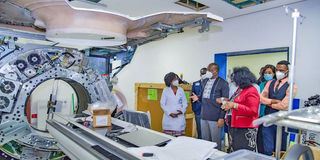For cancer patients, wait for treatment has been winding journey

Health Cabinet Secretary Mutahi Kagwe during the installation of a 3T MRI machine at Kenyatta University Teaching, Referral and Research Hospital. With him are the hospital’s board chairperson Prof Olive Mugenda (right) and the Head of Radiology Dr Sarah Osiemwo.
What you need to know:
- Kenyans seeking cancer treatment abroad, including India, South Africa and Dubai, spend an estimated Sh10 billion annually.
- This is the third MIC in Africa with others in South Africa and Egypt.
- The firm has since delivered the first phase of the equipment, including a 3T MRI and 256-Slice CT Scan.
Long queues and delays caused by lack of accessible and affordable cancer treatment has been blamed for worsening patient conditions.
Many cancer patients are placed on the waiting list for even a year before they are scheduled for cancer treatment because the facilities offering the services are inadequate and personnel few.
In public hospitals, unlike in private facilities, the diagnosis equipment is scarce. Private hospitals are too expensive for most Kenyans in need of treatment. This has since forced many Kenyans to travel abroad for treatment.
It is estimated that 80 per cent of patients diagnosed with cancer in Kenya are in advanced stages. On top of this, the high rates of misdiagnosis and inadequate screening have been hindering early detection of cancer.
According to the World Health Organization the African region has less than 20 radio therapy equipment, coupled with a shortage of specialists, restricting access to cancer care for a majority of the patients.
On most occasions, screening of cancer patients normally happens too late, a challenge that has impacted cancer patients living outside big cities like Nairobi and Mombasa.
Long waiting lists
Most cancer patients come from Nairobi, Kisumu, Meru, Mombasa, Kakamega, Kiambu, Nyeri, Nakuru, Bomet, Embu and Eldoret, according to the National Cancer institute.
According to the Journal of Global Oncology, an oncologist in Kenya attends to more than 3,000 cancer cases compared to less than 150 in the US and China.
By August last year, the country had at least 35 qualified oncologists and 20 others under training. At that time, there were 35 oncology nurses and 10 clinicians trained in cancer management.
Kenyatta National Hospital (KNH) and Moi Teaching and Referral Hospital (MTRH) are the only public facilities providing comprehensive cancer treatment.
Some eight regional centres have been opened across the country, but still patients outnumber specialists, resulting in long waiting lists.
Current data shows that cancer patients attending care at the regional county hospitals are approximately 1,300 while those at KNH and MTRH (combined) are approximately 3,700.
Aga Khan University Hospital, Nairobi, is the only facility in East Africa with a comprehensive cancer centre though it is not within the reach of many.
When Maurice Otieno fell ill last year, he went to a private hospital in the country where he was diagnosed with throat cancer. He spent more than Sh1 million just on screening alone to check what the problem was.
When they finally diagnosed the problem, he could not continue treatment at the same hospital because he did not have the money.
He opted to take his treatment at KNH. But, the queue was too long. He went for an appointment in April and was booked for November.
He was surviving on painkillers, and did not have the money to seek treatment outside the country.
One month after starting his treatment, Otieno succumbed to the disease.
Expensive treatment
According to the Health ministry’s data, around 30,000 people die from cancer yearly in Kenya and an estimated 47,887 Kenyans are diagnosed with cancer annually.
However, the long wait, expensive treatment and late diagnosis will be a thing of the past after another cancer centre with early-detection machines was set up at the Kenyatta University Teaching, Research and Referral Hospital this year.
The Sh1.8 billion, 36-month project will see Kenyans and those in centres in East and Central Africa access advanced care at a more affordable cost compared to that of private hospitals.
The Integrated Molecular Imaging Centre includes a 76-bed oncology centre and a 20-bed renal unit. It is also the first hospital to operationalise the pure referral model meant to be for highly specialised and emergency cases.
This is the third MIC in Africa with others in South Africa and Egypt.
Apart from early diagnosis and possible management options for cancer and renal diseases, it will also significantly boost patients recovery rate. “The centre will also address the gap of “lack of efficient cancer screening and diagnosis” in the East African region, says Dr Sarah Osiemwo, Head of Radiology department at the hospital.
Through the American conglomerate, General Electric Healthcare (GE), the centre will be equipped with molecular imaging equipment, including PET-CT to create 3D images. What does this mean? It will help to identify the cancer cells inside the body and show areas of cell activity, enabling detection of tumours.
The equipment will also scan and detect the location and extent of cancer that has recurred after initial treatment and spread to other parts of the body. PET-CT scans can detect cancer earlier than either CT scans alone or MRI scans.
Train team
The firm has since delivered the first phase of the equipment, including a 3T MRI and 256-Slice CT Scan. This diagnostic tools help experts to detect the earliest stages of cancer so that they can treat it and prevent it from progressing further.
Apart from providing the machines, GE will train the cancer centre team over an 18-month period. The remaining machines are likely to be delivered in the country by the end of March 2021.
When completed, the facility will scan 60 cancer patients per day.
The National Non-Communicable Diseases Alliance, a lobby that promotes action against NCDs, said this could be a game changer for Kenya. “With the additional cancer centres, we have many options to choose from and this will limit our travels. It will be a relief to many who have to fundraise to meet the huge cost of treatment,” said the lobby’s vice chairperson David Makumi.
Kenyans seeking cancer treatment abroad, including India, South Africa and Dubai, spend an estimated Sh10 billion annually.
Prof Olive Mugenda, KU hospital chairperson, told HealthyNation that about 4,737 cancer out-patients and 686 in-patients have been attended to at the facility since its operationalisation in October 2019.
Most of the patients come from all over Kenya, with the majority coming from Kiambu, Nairobi, Nyeri, Meru, Murang’a, Kirinyaga, Nyahururu, Laikipia and also within East African countries.
Early treatment
“We are delighted to be partnering with Kenyatta Hospital to create the largest public cancer screening diagnosis and treatment centre in Kenya and this region,” said Farid Fezoua, President and CEO for GE Africa.
“Cancer may be treatable if it is detected early, and we hope that this centre will increase the accessibility of comprehensive care for patients, enabling earlier diagnosis, better understanding of individual cancers via improved imaging and staging capabilities for better and early treatment of cancers in Kenya.”


